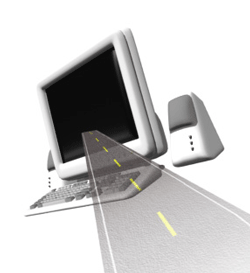By: John Shepler
Business broadband offers a wider selection compared to residential options. While it’s true that some business internet services come with a higher price tag due to their advanced features, there are also affordable choices comparable to residential broadband, suitable for specific needs. Let’s delve into the various high-speed business internet services available and how to determine the best fit for your location.
Among the most budget-friendly options is cable broadband, technically referred to as DOCSIS 3.0 or D3. Utilizing the same coaxial cable as cable TV, it presents an advantage for businesses like bars or doctor’s offices by allowing bundled packages of broadband and TV, or even a “triple play” that includes telephone services.
The extensive cable subscriber base contributes to the attractive pricing. However, this also presents a limitation as bandwidth is shared among many users. The advertised “up to” bandwidth represents the maximum achievable speed, which can fluctuate depending on the online activity of other subscribers.
Cable broadband’s unregulated status as an “information service” with “best effort” delivery further contributes to its affordability. Unlike telecom services bound by Service Level Agreements (SLAs) that guarantee performance standards and outage response times, cable broadband operates differently.
To determine if business cable broadband suits your needs, consider your business size and potential benefits from bundled packages. If you’ve had positive experiences with residential cable broadband, the business version might be a suitable choice.
Wireless Broadband
In scenarios where wires are impractical, 3G and 4G cellular broadband present a viable option. This wireless connectivity allows mobility with smartphones, tablets, and laptops. High-performance fixed transceivers are particularly useful for temporary setups like pop-up stores or construction sites.
However, wireless broadband often comes with bandwidth limitations and monthly download caps. While sufficient for tasks like credit card processing, email, and occasional web browsing, it may not be ideal for multiple users, extensive video downloads, or software updates.
Satellite internet, a separate fixed wireless service, relies on a small dish with a clear view of the southern sky. Similar to cellular broadband, it faces bandwidth constraints and latency issues, making it unsuitable for real-time applications like VoIP or video conferencing.
T1 lines
T1 represents a traditional and reliable broadband solution for businesses, offering equal upload and download speeds of 1.5 Mbps dedicated solely for your use. This dedicated bandwidth and low latency make it a reliable choice for various business applications.
While suitable for smaller operations, the 1.5 Mbps bandwidth might be a limiting factor for some. Although it can be scaled up to 12 Mbps by combining multiple T1 lines (bonded T1), the cost increases proportionally with each added line.
T1 and bonded T1 services excel in providing the necessary performance for tasks like cloud services and secure point-to-point connections. Moreover, they are widely available wherever traditional telephone lines exist.
DS3 or T3
Considered the legacy upgrade path from T1, T3, also known as DS3, offers a significant bandwidth boost to 45 Mbps, generally sufficient for small to medium-sized businesses. Like T1, DS3 boasts high reliability, low latency, jitter, and packet loss. It can be configured for both direct point-to-point connections and internet access.
The primary drawbacks of DS3 are its higher cost compared to other options and limited availability. Requiring fiber optic lines for signal transmission, DS3’s reach depends on the proximity of fiber infrastructure.
Ethernet over Copper
A direct competitor to T1, Ethernet over Copper (EoC) utilizes existing twisted-pair copper wires but bonds multiple pairs to achieve higher bandwidths ranging from 3 to 20 Mbps, with some locations offering up to 50 or 100 Mbps.
EoC’s widespread availability and cost-effectiveness compared to T1 or DS3 make it an attractive option. However, bandwidth decreases over distance, limiting higher speeds to locations closer to the telco office. Nevertheless, when available, EoC presents an excellent choice for business broadband.
Ethernet over Fiber
Similar to EoC, Ethernet over Fiber (EoF) delivers high-performance broadband at a competitive price, leveraging fiber optic cables to achieve even greater bandwidth capacities. Options range from 10 Mbps up to 100 Mbps, 1000 Mbps, 10 Gbps, and in select areas, even 100 Gbps.
Fiber’s future-proof nature and Ethernet’s scalability make EoF a compelling choice. Starting with a bandwidth plan that meets current needs and easily upgrading with a simple call to the provider provides flexibility. Such upgrades typically require no equipment changes and are often implemented immediately or within a short timeframe.
Ultimately, the optimal broadband solution for your business depends on a balance of cost, performance, and availability. Obtaining comprehensive quotes for high-speed business Internet services specific to your location will help you make an informed decision.


